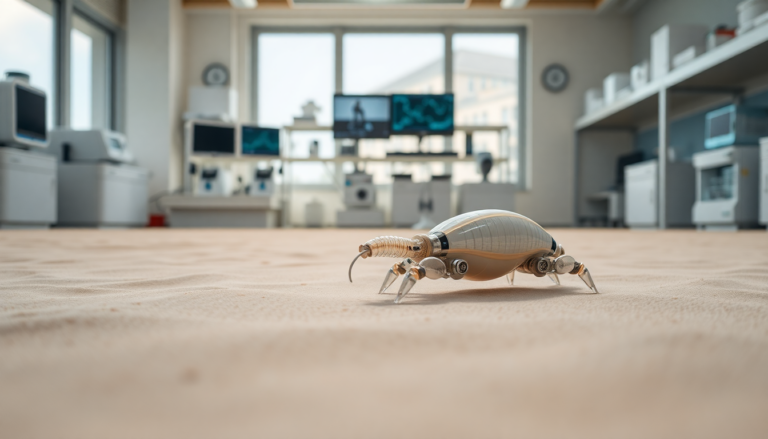Argomenti trattati
Advancements in Soft Robotics
Recent developments in soft robotics are transforming how machines interact with our environment. Researchers have discovered that mimicking the unique movement patterns of nematodes can significantly enhance the ability of soft robots to navigate challenging terrains, such as shifting sands. This innovation opens up new opportunities for deploying robots in disaster relief, search and rescue missions, and various other applications where conventional robots struggle. By utilizing flexible materials and advanced algorithms, these robots can perform jumps and agile movements, adapting to unpredictable surfaces and obstacles.
The Science Behind Sunscreen
As we approach warmer months, understanding the science of sunscreen becomes crucial. Sunscreen plays an essential role in protecting our skin from harmful UV rays, but the mechanisms behind its effectiveness are often misunderstood. Recent studies have raised questions about the potential toxicity of certain sunscreen ingredients. By exploring how these products work and their long-term effects on health and the environment, consumers can make informed choices. This section will examine the different types of sunscreen, active ingredients, and their implications for skin health.
Innovative Night-Vision Technology
Another exciting development in technology is the creation of a room-temperature infrared sensor that offers night-vision capabilities without the bulk of traditional devices. This lightweight sensor can be mounted on ordinary glasses, making advanced vision technology accessible and practical for everyday use. Such innovations could revolutionize personal safety and enhance experiences in low-light environments, from urban exploration to nighttime sports.
Revolutionizing Maritime Engineering
The BYD SHENZHEN, a colossal maritime vessel, represents a significant leap in engineering design. Measuring an impressive 219.9 meters in length and 37.7 meters in width, this ship boasts 16 decks and showcases the potential of modern engineering in the maritime sector. Innovations like these not only enhance transportation efficiency but also pave the way for future developments in shipbuilding and design, focusing on sustainability and performance.
Advancements in Hydrogen Production
In the realm of renewable energy, a new system has emerged that achieves an impressive hydrogen production rate of 1.4 mmol per square centimeter per hour. This breakthrough could play a crucial role in the transition towards cleaner energy sources, as hydrogen is increasingly seen as a viable alternative to fossil fuels. By improving hydrogen production methods, researchers are working towards a more sustainable energy future, reducing our reliance on carbon-intensive energy sources.
Origami-Inspired Robotics
Princeton engineers have taken inspiration from the ancient art of origami to develop a metabot system that blurs the lines between materials and robotics. This innovative approach allows for the creation of robots that can fold and adapt their shapes, offering unprecedented versatility in various applications. Such advancements highlight the importance of interdisciplinary collaboration in driving technological progress and expanding the horizons of robotic capabilities.
Enhancing Robotic Efficiency with RHyME
The RHyME system represents a significant advancement in robotic learning. Requiring just 30 minutes of data collection, it boosts task success rates by over 50% compared to previous methodologies. This efficiency not only streamlines robotic training processes but also enhances the overall effectiveness of robots in real-world applications, from industrial automation to service-oriented tasks.
Exploring the Depths of the Arabian Sea
Recent research indicates that nearly 60% of recorded milky-sea events occur within a specific corridor of the Arabian Sea. These bioluminescent phenomena, caused by marine microorganisms, offer a glimpse into the ecological dynamics of our oceans. Understanding these occurrences can provide valuable insights into marine life and the health of oceanic ecosystems, highlighting the need for ongoing research and conservation efforts.
Transforming Wastewater Treatment into Energy Solutions
In Europe, there are approximately 80,000 sewage treatment plants that could be converted into sites for generating renewable energy. This innovative approach not only addresses the issue of waste management but also presents a sustainable solution to energy production. By harnessing the potential of wastewater, we can reduce environmental impact while providing a source of clean energy for various applications.
Emerging Technologies in Healthcare
Recent advancements in healthcare technology are paving the way for more effective treatments and diagnostics. An antimicrobial breakthrough involving chlorhexidine, commonly used in dental treatments, showcases the potential for developing new therapeutic applications. Such innovations can enhance patient care, reduce infection rates, and improve overall health outcomes.
Addressing the Challenges in the Automotive Industry
The automotive industry is facing a decline in revenue, with car sales dropping by 20% year-on-year. This downturn highlights the importance of innovation and adaptation in an evolving market. As consumers shift towards sustainable transportation options, manufacturers must embrace technologies that cater to this demand. Electric vehicles, autonomous driving technologies, and improved fuel efficiency will be critical in revitalizing the industry.
Nanoplastics, tiny plastic particles measuring less than 1,000 nanometers, pose a significant environmental threat. Invisible to the naked eye, these particles can infiltrate ecosystems and impact wildlife. Understanding their implications and developing strategies to mitigate their effects is essential for safeguarding our planet. Ongoing research into nanoplastics will be crucial in shaping future environmental policies and consumer practices.
Innovative Solutions in Dentistry
Researchers are exploring the potential of bioengineered teeth that could one day replace traditional fillings and implants. This natural alternative aims to offer a more sustainable and effective solution to dental issues, reflecting the growing trend towards biomimicry in medical technology. As the field of dentistry evolves, such innovations could revolutionize patient experiences and outcomes.

